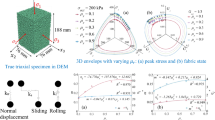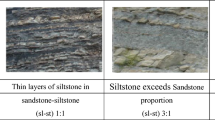Abstract
In order to simulate the soil response during principal stress rotation, anisotropic unified hardening (UH) model is developed within the framework of elastoplastic theory. Without introducing any additional mechanism to display the role of stress rotation specifically, this model achieves the simulation by considering the material anisotropy. The effect of inherent anisotropy is reflected using the anisotropic transformed stress method, but a new formula for the stress map** is adopted to keep the mean stress unchanged. Analysis indicates that from the view of the transformed stress tensor, the anisotropic soil is subjected to loading during pure rotation of principal stress axes, so that plastic strains can be calculated. To represent the induced anisotropy, a fabric evolution law is proposed based on laboratory and numerical test results. At the critical state, the fabric tensor reaches a stable value determined by the stress state, while the critical state line is unique in the plane of void ratio versus mean stress. The anisotropic UH model has concise formulation and explicit elastoplastic flexibility matrix and can provide reasonable predictions for the deformation of anisotropic soils when principal stresses rotate.









Similar content being viewed by others
References
Been K, Jefferies MG, Hachey J (1991) Critical state of sands. Géotechnique 41:365–381
Cai Y, Yu HS, Wanatowski D et al (2012) Noncoaxial behavior of sand under various stress paths. J Geotech Geoenviron Eng 139:1381–1395
Chang CS, Yin ZY (2010) Micromechanical modeling for inherent anisotropy in granular materials. J Eng Mech 136:830–839
Dafalias YF (2016) Must critical state theory be revisited to include fabric effects? Acta Geotech 11:479–491
Gao ZW, Zhao JD (2017) A non-coaxial critical-state model for sand accounting for fabric anisotropy and fabric evolution. Int J Solids Struct 106–107:200–212
Gao ZW, Zhao JD, Li XS et al (2014) A critical state sand plasticity model accounting for fabric evolution. Int J Numer Anal Methods Geomech 38:370–390
Guo N, Zhao JD (2013) The signature of shear-induced anisotropy in granular media. Comput Geotech 47:1–15
Gutierrez M, Ishihara K, Towhata I (1993) Model for the deformation of sand during rotation of principal stress directions. Soils Found 33:105–117
Gutierrez M, Wang J, Yoshimine M (2009) Modeling of the simple shear deformation of sand: effects of principal stress rotation. Acta Geotech 4:193–201
Ishihara K (1993) Liquefaction and flow failure during earthquakes. Géotechnique 43:351–415
Ishihara K, Towhata I (1983) Sand response to cyclic rotation of principal stress directions as induced by wave loads. Soils Found 23:11–26
Jia GW, Zhan TL, Chen YM et al (2009) Performance of a large-scale slope model subjected to rising and lowering water levels. Eng Geol 106:92–103
Kuhn MR, Sun WC, Wang Q (2015) Stress-induced anisotropy in granular materials: fabric, stiffness, and permeability. Acta Geotech 10:399–419
Lashkari A, Latifi M (2008) A non-coaxial constitutive model for sand deformation under rotation of principal stress axes. Int J Numer Anal Methods Geomech 32:1051–1086
Li XS, Dafalias YF (2004) A constitutive framework for anisotropic sand including non-proportional loading. Géotechnique 54:41–55
Li XS, Dafalias YF (2012) Anisotropic critical state theory: role of fabric. J Eng Mech 138:263–275
Li X, Li XS (2009) Micro-macro quantification of the internal structure of granular materials. J Eng Mech 135:641–656
Li X, Yu HS (2010) Numerical investigation of granular material behaviour under rotational shear. Géotechnique 60:381–394
Matsuoka H, Sakakibara K (1987) A constitutive model for sands and clays evaluating principal stress rotation. Soils Found 27:73–88
Miura K, Miura S, Toki S (1986) Deformation behavior of anisotropic dense sand under principal stress axes rotation. Soils Found 26:36–52
Nakata Y, Hyodo M, Murata H et al (1998) Flow deformation of sands subjected to principal stress rotation. Soils Found 38:115–128
Oda M (1993) Inherent and induced anisotropy in plasticity theory of granular soils. Mech Mater 16:35–45
Oda M, Nakayama H (1989) Yield function for soil with anisotropic fabric. J Eng Mech 115:89–104
Qian JG, Du ZB, Yin ZY (2017) Cyclic degradation and non-coaxiality of soft clay subjected to pure rotation of principal stress directions. Acta Geotech. https://doi.org/10.1007/s11440-017-0567-8
Roscoe KH, Schofield A, Wroth CP (1958) On the yielding of soils. Géotechnique 8:22–53
Salager S, Francois B, Nuth M et al (2013) Constitutive analysis of the mechanical anisotropy of Opalinus Clay. Acta Geotech 8:137–154
Symes MJ, Gens A, Hight DW (1984) Undrained anisotropy and principal stress rotation in saturated sand. Géotechnique 34:11–27
Tobita Y, Yanagisawa E (1992) Modified stress tensors for anisotropic behavior of granular materials. Soils Found 32:85–99
Tong ZX, Zhang JM, Yu YL et al (2010) Drained deformation behavior of anisotropic sands during cyclic rotation of principal stress axes. J Geotech Geoenviron Eng 136:1509–1518
Tong ZX, Fu PC, Zhou SP et al (2014) Experimental investigation of shear strength of sands with inherent fabric anisotropy. Acta Geotech 9:257–275
Tsutsumi S, Hashiguchi K (2005) General non-proportional loading behavior of soils. Int J Plast 21:1941–1969
Wan RG, Guo PJ (2001) Drained cyclic behavior of sand with fabric dependence. J Eng Mech 127:1106–1116
Wang ZL, Dafalias YF, Shen CK (1990) Bounding surface hypoplasticity model for sand. J Eng Mech 116:983–1001
Wang Z, Yang YM, Yu HS (2017) Effects of principal stress rotation on the wave-seabed interactions. Acta Geotech 12:97–106
Wu W (1998) Rational approach to anisotropy of sand. Int J Numer Anal Methods Geomech 22:921–940
**e YH, Yang ZX, Barreto D et al (2017) The influence of particle geometry and the intermediate stress ratio on the shear behavior of granular materials. Granul Matter 19:35
Yang ZX, Wu Y (2017) Critical state for anisotropic granular materials: a discrete element perspective. Int J Geomech 17:04016054
Yang YM, Yu HS (2013) A kinematic hardening soil model considering the principal stress rotation. Int J Numer Anal Methods Geomech 37:2106–2134
Yang ZX, Li XS, Yang J (2007) Undrained anisotropy and rotational shear in granular soil. Géotechnique 57:371–384
Yao YP, Sun DA (2000) Application of Lade’s criterion to Cam-clay model. J Eng Mech 126:112–119
Yao YP, Wang ND (2013) Transformed stress method for generalizing soil constitutive models. J Eng Mech 140:614–629
Yao YP, Sun DA, Matsuoka H (2008) A unified constitutive model for both clay and sand with hardening parameter independent on stress path. Comput Geotech 35:210–222
Yao YP, Hou W, Zhou AN (2009) UH model: three-dimensional unified hardening model for overconsolidated clays. Géotechnique 59:451–469
Yao Y, Tian Y, Gao Z (2017) Anisotropic UH model for soils based on a simple transformed stress method. Int J Numer Anal Methods Geomech 41:54–78
Yoshimine M, Ishihara K, Vargas W (1998) Effects of principal stress direction and intermediate principal stress on undrained shear behavior of sand. Soils Found 38:179–188
Yu HS, Yang LT, Li X et al (2015) Experimental investigation on the deformation characteristics of granular materials under drained rotational shear. Geomech Geoeng 11:47–63
Zhao J, Guo N (2013) Unique critical state characteristics in granular media considering fabric anisotropy. Géotechnique 63:695–704
Zhu EY, Yao YP (2015) Structured UH model for clays. Transport Geotech 3:68–79
Acknowledgements
This study was supported by the National Natural Science Foundation of China (Grant Nos. 11672015 and 51579005), the National Basic Research Program of China (Grant No. 2014CB047001), and the Academic Excellence Foundation of BUAA for PhD Students (Grant No. 2017052).
Author information
Authors and Affiliations
Corresponding author
Additional information
Publisher's Note
Springer Nature remains neutral with regard to jurisdictional claims in published maps and institutional affiliations.
Appendix: Explicit expressions of the partial differentials in the plastic flexibility matrix
Appendix: Explicit expressions of the partial differentials in the plastic flexibility matrix
-
1.
$$\frac{\partial f}{{\partial \tilde{\sigma }_{ij} }}$$
According to the chain rule,
where
Besides, \(\frac{\partial f}{{\partial \tilde{p}}}\) and \(\frac{\partial f}{{\partial \tilde{q}}}\) can be derived from the yield function (Eq. 13) as follows
-
2.
$$\frac{\partial f}{{\partial \sigma_{ij} }}$$
First, the partial differential with respect to \(\bar{\sigma }_{ij}\) is calculated by
Note that one can always get \(\tilde{p} = \bar{p}\) and \(\tilde{q} = \bar{q}_{\text{c}}\) from the transformed stress Eq. (4), so that
Then according to the chain rule, the partial differential with respect to \(\sigma_{ij}\) is equal to
where based on the modified stress Eq. (3),
-
3.
$$\frac{\partial f}{{\partial F_{ij} }}$$
According to the chain rule,
Rights and permissions
About this article
Cite this article
Tian, Y., Yao, YP. Constitutive modeling of principal stress rotation by considering inherent and induced anisotropy of soils. Acta Geotech. 13, 1299–1311 (2018). https://doi.org/10.1007/s11440-018-0680-3
Received:
Accepted:
Published:
Issue Date:
DOI: https://doi.org/10.1007/s11440-018-0680-3




